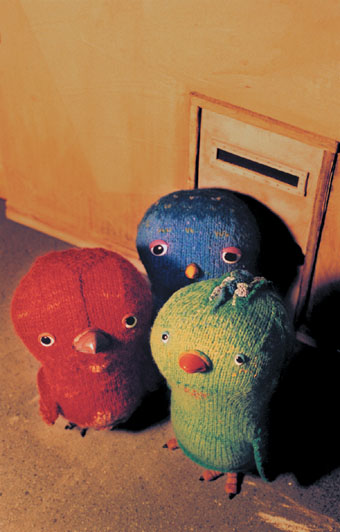Animation: In the moment
Keith Gallasch

It's Like That
The nominees for best animation this year for the most part look good, healthily embracing a range of techniques with the computer as only one tool among others. Robert Stephenson’s Lucky for Some (11’10) is the conventional work in the cluster, a clay animation that looks pretty familiar if deftly done—no playing with the limits of clay here. Locations shift between beach, casino and police station as the principals are interrogated by police. So too our opinions of these seeming innocents transform dramatically as the convoluted plot about chance discoveries and murderous outcomes unfolds. Perhaps the selectors for the award were taken by the short story twist and the grim seriousness underlying comic appearances. I found it hard to locate the film’s tone and was more attracted to the other contenders who put narrative aside, as in Pia Borg’s Footnote, or kept it in its place in the interplay between moment and momentum as in Sejong Park’s Birthday Boy and It’s Like That (7’15) by the Southern Ladies Animation Group.
Birthday Boy (9’30) is, as Dan Edwards has described it in OnScreen (RT 62, p21), a simple tale resonating with many meanings. A child in a Korean village ruined by war and devoid of community himself plays at war, making military toys and wearing his father’s dog tags, unaware of the soldier’s death. In an early chilling moment the boy hurls a stone at and hits a distant cyclist. The film’s great strength is in its evocation of an innocent interiority, alternating the animation equivalents of long shots with extreme closeups that not only focus on what obsesses the boy but bring him face to face, almost full screen, with the viewer, a curious and affecting mirror experience. Birthday Boy is an intense and beautifully crafted film in the anime style, nuancing its anti-war premise with questions about innocence and learning. The film won the Yoram Gross Animation award at this year’s Dendy Awards for Short Films at the Sydney Film Festival; Siggraph Art Show, Best Animated short 2003, USA; and the Prix Ars Electronica 2004 Award of Distinction for Computer Animation/visual effects, Austria.
Pia Borg’s Footnote (6’00) is an eccentric modernist fantasia harking back in style and content to Max Ernst and the worlds conjured by the likes of Franz Kafka and Bruno Schulz. But here the layering is mobile, rhythmically alternating between the levels of a house and also the codes of writing, musical notation and dance that propel and obsess its mechanistic characters. The animation reveals a contemporary virtuosity here and there by escaping the flatness of much collage with, for example, some striking depth of field as we are swept around the driven pianist. Antony Pateras’ score for piano both heightens and threatens to rupture the metronomic pulse of this alien world of constrained creativity. Footnote was one of the 20 student films from around the world to be shown in the CinÃ(c)fondation section at this year’s Cannes Film Festival.
The mix of animation styles in It’s Like That (7’15) by the Southern Ladies Animation Group (SLAG) at first sight suggests ungainliness, but somehow it all hangs together and to powerful effect. The editing of sound and image and the almost documentary narrative structure (built around the recorded voices of child refugees in Australian detention centres) integrate the linear shifts between and occasional overlays of stop animation, flash and cell drawings. A horizontal line becomes a ship, it squiggles into fire and snakes out to become an outline of Australia —simple enough artistry but juxtaposed with a child’s voice it’s disturbing. Similarly the portrayal of the children as knitted bird puppets seems coy at first but the limited means and our attentive-ness to the voices keeps sentimentality well at bay. It’s Like That was invited to the International Documentary Festival in Amsterdam in 2003.
Park and Borg are recent graduates of AFTRS and VCA respectively. Melbourne-based SLAG is a collaborative venture, a model freshly emergent in film here and there around the country. All 3 have already made successful forays into the international festival scene, justifying the AFI Awards selection and a sign yet again of the strengths of Australian animation. As for a winner, for me it’s a tie between Birthday Boy and It’s Like That, between a fully visually realised psychological acuity on the one hand and an agitprop deployment of the means to hand, but with great sensitivity, on the other.
RealTime issue #63 Oct-Nov 2004 pg. 23






